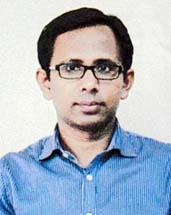
Dr Md Aktaruzzaman :
Covid-19 pandemic has raised significant challenges as well as opportunities for the higher education community worldwide to learn and explore. During the pandemic a particular challenge was the urgent and unexpected request for previously face-to-face university courses to be taught online and vice versa near about the end of pandemic. The shifting from traditional face-to-face education to online was not an easy journey for many institutions across the world – a bunch of changes in terms of digital competencies, pedagogical knowledge, psychosocial counselling, varied levels of interaction, engagement and assessment strategies, support structures, etc. were required to be adopted in the institutional policies and practices. Now at the post-Covid stage should we go back to the traditional face-to-face education leaving all these remarkable shifts or changes behind? – Certainly not. Then what should be our strategies at the post-Covid education system in a digital world?
In the 4th industrial revolution era with the high speed of Internet, the post-Covid education is expected to be neither fully online nor face-to-face but rather phygital in Education 4.0. Let’s start by understanding digital learning, which can be defined as any type of learning that is accompanied by digital technology or by instructional practice that makes effective use of it.A new trend called phygital (a blend of physical and digital space, phygital = physical + digital) learning is gaining popularity in recent times. It is the concept of using technology to integrate the digital learning space with the physical world for the purpose of providing a unique interactive experience to the learners. Phygital is more comprehensive than digital or face-to-face education and it is NOT blended learning as the latter does not blend the best practices of face-to-face and online education instead operates both singly.
To ensure digital education at the higher education sector, each university should have a customized and centrally managed learning management system (LMS) such as Moodle, Canvas, Blackboard or at least Google Classroom. Besides, smart-education type platform is important to have for monitoring, management and accountability of all academic and administrative tasks. Universities should provide necessary arrangements to ensure that all teachers and staff effectively uses these platforms regularly. Modern LMS integrates web conferencing, learning analytics, video engagement, interactive digital contents and mobile applications, thus its usage enables changes in the quality of education. There is no alternative of professional development in digital education system, particularly for reducing the gap of practices in the academia and industry as well as for developing ethics and professionalism of teachers. Massive Open Online Course (MOOC) platform could be highly useful in this regard. Student feedback and accountability of teachers – these two aspects should be the key considerations for continuing digital education. Student monthly feedback and activities for each course are carefully analyzed and meaningful patterns are extracted to improve teaching-learning. Each teacher should submit a monthly report with evidence following a rubric comprising 8-10 aspects to SmartEdu type system. Altogether, these approaches may have significant impacts to quality education, if universities monitor and oversee these tasks regularly and sincerely.
Summative assessment is the biggest challenge for online education, particularly in the developing countries where device, price and speed of Internet, and socio-economic issues are prevalent. In our assessment system 70-80 percent marks are assigned to summative exams for mid-term and semester final, which does not commensurate at all to the modern assessment strategy followed around the world. On the other hand, online proctored exams do not have much success stories particularly at this region. Thus, mixed approach of assessment could be effective, for example, 60-70 percent marks for creative assignment, quiz, case studies, presentation, project development, etc. and the rest 30-40 percent marks could be allocated for traditional type of examinations. A consortium could be formed by including Bangladesh Open University, National University, and Union Digital Center. This may result in high quality blended and online education particularly assessment, counselling, video streaming like services to all utilizing their nationwide large physical infrastructures.
Online education is not a problem by itself but rather the provider institution offering the program should be the key focus to investigate. For instance, an online program offered by Harvard University won’t be the same quality of that at Dhaka University. Quality is important but quantity needs to be focused as well. Every year approximately 10 lakh students pass HSC exam, this year it is 13 Lakh 67 thousand while public (except National University) and private universities can accommodate only 2 Lakh 50 thousands aspirant students. And it is not possible to change the physical infrastructure overnight. Therefore, online education is the best alternative in today’s Digital Bangladesh. Online education should be patronized and liberalized through standardization of policies and practices by increasing the number of provider institutions in both public and private sectors on a competitive and transparent basis. The policy must follow a standard set of criteria, which may include but not limited to: (i) years of experience in blended, online and digital education; (ii) infrastructural resources (e.g. IT); (iii) human resources (w.r.t. digital and pedagogical competency); (iv) rigorous quality assurance; (v) periodic compliance requirement; (vi) proper documentation and reporting of student feedback; (vii) support system; (viii) professional development options; (ix) incorporation of teaching-learning analytics; (x) educational guidance and counselling, among others.
Bangladesh is yet to mark its presence in the global online education industry, which could be the third biggest source of earning revenues after remittance and garment industry, if this sector is given due importance and carefully visioned straightaway. Therefore, now it is the right time for our policy makers to rethink the online education policy.
(Dr Md Aktaruzzaman is Digital Education Expert & Director, Blended Learning Center Daffodil International
University).

